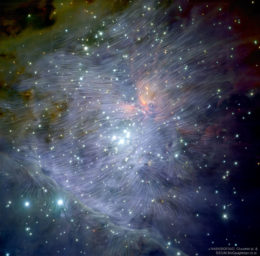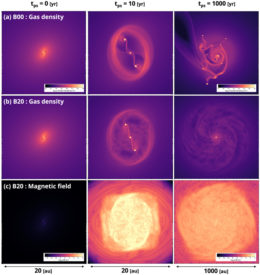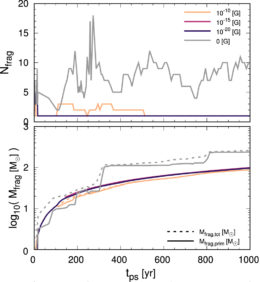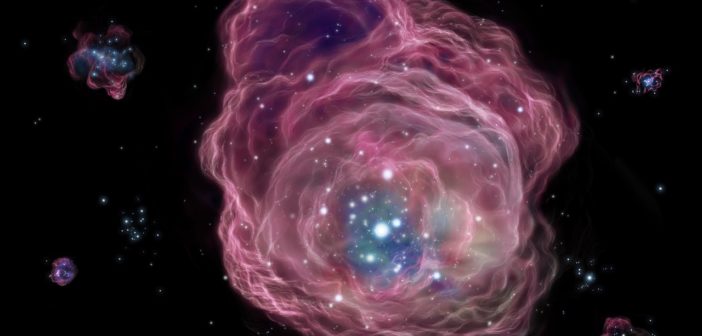The first stars in the universe, known as Population III stars, formed just a few hundred million years after the Big Bang. While researchers expect that most Population III stars led bright, brief lives, those with masses less than 0.8 solar mass would still be shining faintly today. Can magnetic fields in the early universe explain why we’ve yet to find these stars?
Producing Population III Stars

An infrared image of the Orion star-forming region with magnetic field lines measured by the Stratospheric Observatory for Infrared Astronomy traced on top. [NASA/SOFIA/D. Chuss, et al., and European Southern Observatory/M.McCaughrean, et al.]
Previous research suggests that the early universe was suffused with a subtle magnetic field that was about a trillion times weaker than the fields measured in typical star-forming regions in the universe today. Magnetic fields play an important role in shaping — and sometimes suppressing — star formation in the local universe, leading researchers to wonder if the weak magnetic fields in the early universe could have halted the formation of low-mass stars entirely.

Simulation results for the unmagnetized case (top row) and the case in which the magnetic field strength was 10-20 Gauss (middle and bottom row). The top and middle rows show how the density of the gas varied between the two simulations at 0, 10, and 1,000 years of simulation time. The bottom row shows how the magnetic field strength was amplified and evolved over time in the magnetized case. Click for high-resolution version. [Hirano & Machida 2022]
Magnetic Magnification
Shingo Hirano (University of Tokyo and Kyushu University, Japan) and Masahiro Machida (Kyushu University, Japan) modeled the collapse of a cloud of gas under the conditions present in the early universe to understand how magnetic fields might have influenced the formation of the first stars.
The team performed magnetohydrodynamic simulations of a gas cloud with weak initial magnetic field strengths of 0, 10-20, 10-15, and 10-10 Gauss. In the unmagnetized case, the cloud fragmented into a massive (~200 solar masses) central protostar and a handful of smaller protostars, all of which persisted until the end of the simulation at 1,000 years.
In the magnetized cases, on the other hand, the rapid rotation of the massive young star forming at the center of the cloud wound the magnetic field tighter and tighter, boosting the magnetic field strength up to 1,000 Gauss. The strong magnetic field prevented the cloud from fragmenting further, and the few small protostars that started to form dissipated entirely, leaving only the massive protostar at the end of the simulation. This result suggests that even a weak magnetic field can be amplified enough to stop small protostars from forming, meaning that the first stars may have all formed alone.

The number of protostellar fragments formed (top) and the overall mass of protostars formed (bottom) in all simulations. [Adapted from Hirano & Machida 2022]
A Turbulent Twist
Hirano and Machida caution that while their simulations suggest that the magnetic fields in the early universe can prevent the formation of low-mass stars, other factors may influence the formation of the first stars; if the star-forming gas is turbulent, for example, it might be more inclined to fragment into multiple stars. Similarly, the slow process of diffusion could prevent the magnetic field from growing strong enough to play an important role.
In future work, the authors plan to introduce turbulence into their simulations, test the effects of different rotation rates of star-forming clouds, and extend the simulation out to 100,000 years. In the meantime, the search for Population III stars continues!
Citation
“Exponentially Amplified Magnetic Field Eliminates Disk Fragmentation around Population III Protostars,” Shingo Hirano and Masahiro N. Machida 2022 ApJL 935 L16. doi:10.3847/2041-8213/ac85e0

